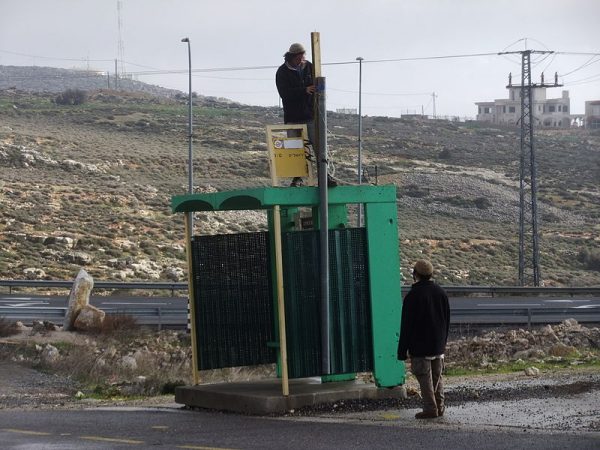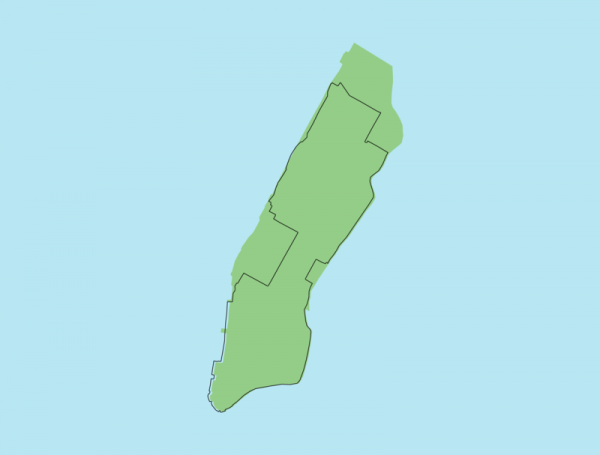A continuous thread of wire wraps around most of Manhattan, raised up overhead and spanning between periodic posts. Most people don’t notice it at all, but to Orthodox Jewish people of the city, it’s vital. This thread conceptually turns public space into private domain, and allows observers of the Sabbath to carry their essential belongings with them. And every week, a rabbi drives around the island to make sure this 20-mile “eruv” line remains intact for the Jewish Sabbath. Modern eruvs encompass large sections of cities around the world, from Toronto to Tel Aviv. New York City’s extensive winding cable only dates back a few decades in its current form, but the tradition is an ancient one.
Per Lorne Rozovsky, a Jewish lawyer and educator with a special interest in rituals, “the literal meaning of the word is blending or intermingling,” and “the concept of an eruv goes back to the principle of Shabbat rest. Under Jewish law on Shabbat, it is forbidden to carry anything — regardless of its weight, size or purpose — from a ‘private’ domain into a ‘public’ one or vice versa.” To bring even a prayer book and reading glasses to a synagogue, for instance, one’s home and place of worship would need to be in the same “domain.” Today, the same restrictions can apply to things like strollers, canes and wheelchairs, though Rabbinic authorities have gone back and forth on this issue.

In ancient times, walled neighborhoods (or entire cities) could be used to frame eruvs, figuratively extending private spaces into public areas. Of course, walling a modern urban metropolis is not practical (though, for a time, some rabbis argued Manhattan’s sea walls could be sufficient to constitute an eruv). So the question becomes: what does it mean for something to actually be a “wall” as such?

“A wall can be a wall even if it has many doorways creating large open spaces,” writes Rozovsky. “This means that a wall does not have to be solid.” By extension, an eruv can be formed by treating, say, public telephone poles with cables slung between them as minimalist “door frames.” Effectively, this creates a system of “walls” that are entirely made up of doorways. And that is the argument behind NYC’s eruv.

“But a single break in any part of the line voids that symbolic space,” reports Michael Inscoe, who spent a day riding around NYC and checking for breaks with a rabbi. “According to the 100 pages devoted to eruvin in the ancient Talmud, the boundary is only effective when the entire line is intact.” Thus, any disconnect is a serious problem.

Sometimes, utility workers will clip a line, or allow it to drop down, and thus breaking the “door frame.” In other cases, weather or accidents can take down a key pole in the network. Fixing these breaks is usually a simple matter, involving some wire, a cutting tool and maybe a small cherry-picker crane. If the line can’t be repaired in time, an entire eruv is declared void until it can be reconnected. Upkeep in NYC runs around $100,000 a year, but the cost is spread around, shared by Orthodox synagogues across Manhattan.
Eruvs can be controversial, though, even within Jewish communities. Some worry that observant Jewish people living in cities with eruvs will become too accustomed to this symbolic boundary’s permissiveness, or won’t notice when a line is broken. Eruvs have also given rise to lawsuits, particularly when local and religious laws clash.
But “despite these problems, the construction of eruvs continues,” writes Rozovsky, even if it often goes unnoticed. “The Washington, D.C. eruv includes the White House. The Strasbourg eruv includes the European Court of Human Rights.” Eruvs can also be found in and around other large global cities including Amsterdam, Manchester, London, Melbourne, Johannesburg, Gibraltar, Venice, and Vienna.

In many cases, though, they go largely unseen by those who don’t have a vested interest in their existence. Naturally camouflaged in urban environments, eruvs tend to blend in with the messy everyday infrastructure of elevated cables that surrounds and connects us.



Comments (10)
Share
I’ve never understood why the eruv isn’t just defined as the region outside the poles, which is topologically equivalent. Then the whole world, bar a small ring of fence, or a proper walled enclosure, could be considered one eruv.
If your religion has features which are no longer acceptable to modern adherents, it seems much better to drop them than cheat, which is what an eruv seems to an outsider.
Yes, and imagine the good which could be done with that $100,000
Your last comment would fit in very well with the reform Jewish community, but it just doesn’t work that way. This solution has been around for centuries, and it’s not an issue of a feature that is “no longer acceptable to modern adherents”.
I am not an expert in Jewish law, but I am sure there is a reason you can’t have an inverse eruv.
Thanks so much for doing this story. I (along with many others, I’m sure) requested that you do this story, and I’m so grateful that you have!!
I think a lot of people perceive that an Eruv is cheating or a loophole, but it’s not. A lot of Jewish laws work like this: there is a rule which cannot be violated, to prevent violation the rule is extended (this is often referred to as “building a fence around it”), if the extension of the rule needs to be suspended for legitimate reasons then it can be suspended, but a symbolic gesture is still needed to remind you of the rule.
To give an analogy: Imagine an alcoholic who is not allowed to drink alcohol. He extends that rule by adding a rule that he cannot walk down a street that has a bar. Then, he gets a job on the same block as his bar. So, he suspends that rule, but he makes a new rule that he has to stop and stand still for 30 seconds before he walks down the block. That symbolic gesture reminds him that the rule still exists.
Eruv law is complex and this is certainly an oversimplification of it. But, in some cases the Eruv is operating as a reminder of “extension laws” that have been suspended.
Yup, this sounds exactly like cheating or creating a loophole. Or, most accurately, abiding by the letter of the law rather than the spirit. If the goal of the Sabbath restriction is to keep folks at home with their families and not “out in the world,” the eruv allows the letter of the law to be following but breaks the spirit.
To use your analogy, it is as if the alcoholic isn’t allowed to *drink* alcohol so he asks a friend to make jello shots which he *eats*. Voila! rule not broken! Of course, the spirit of the rule is totally trashed but hey; he didn’t drink!
Rules on top of rules on top of rules to get around the teaching of the religion. EITHER follow the religion or don’t.
Amazing. You explained the concept of the eruv really well. I kinda had a feeling it would make its way onto 99PI.
(I happen to be studying the section of the Talmud dealing with eruvin and it is no reading…been a year and I am just ten pages in)
You even mentioned how the water could conceivably work for the eruv.
Also, a few years back the Daily Show had a piece on it and it was hilarious.
I personally don’t need an eruv. What am I carrying on Shabbat? I don’t drive, so I don’t need car keys. I can “wear” a house key or have someone who’s home to let me in. I don’t need my wallet. Prayer books are already af the synagogue. An eruv really doesn’t do anything for me. I lived in cities without and didn’t have any difficulty.
However, my wife has always insisted we live in a city with an eruv, or else she’s stuck at home with the kids. You can’t use a stroller without an eruv. You can’t carry a diaper bag. Without an eruv, men go off to synagogue and then off schmoozing with their friends while the women get stuck at home with the kids.
Yes, it’s a women’s issue. This is why In many towns, an eruv is used to attract new residents much like a new modern synagogue or high quality Jewish school. A lot of young couples won’t move into a community without one, so if you want a vibrant community, you build an eruv.
So you’re saying that you are under no obligation to carry the diaper bag or take the kids to shul? So don’t you both need it?